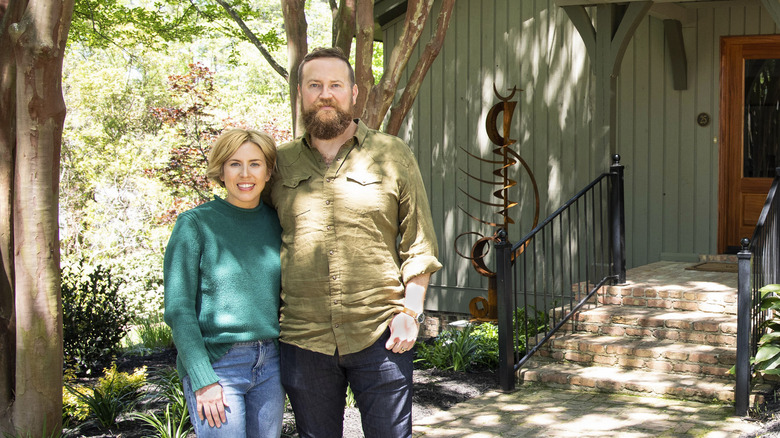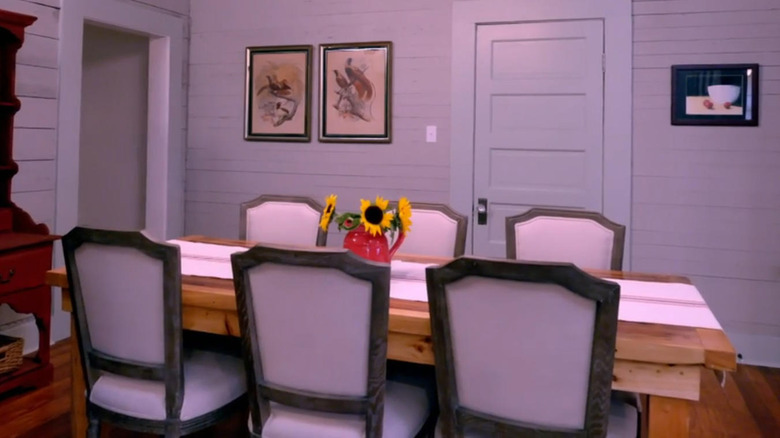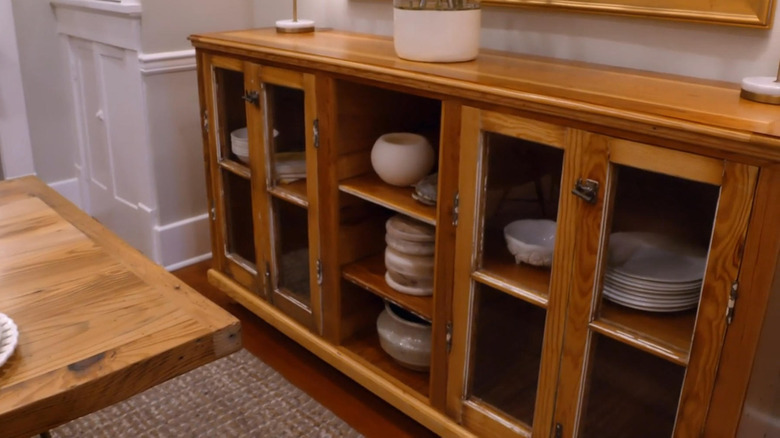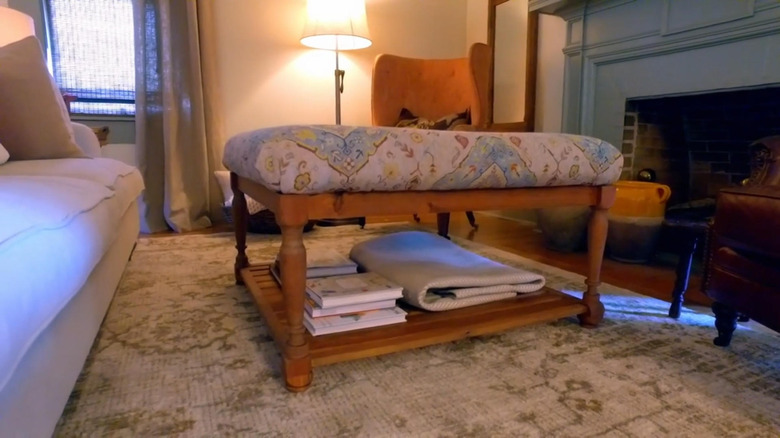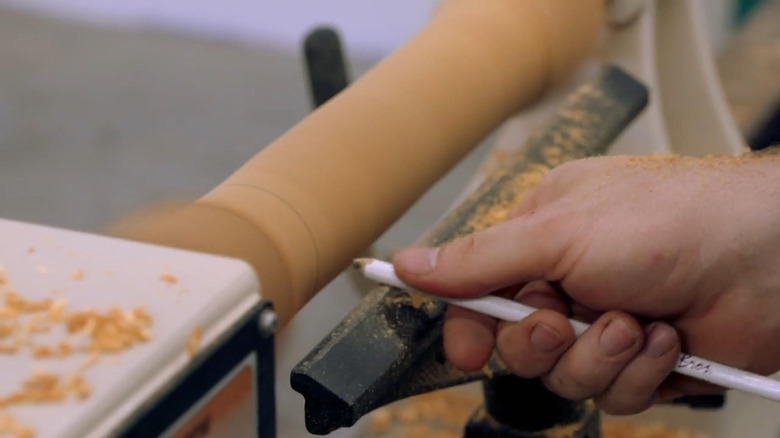HGTV's Ben Napier Shares His Favorite Hometown DIYs (& Tricks For Custom Cuts)
The custom pieces Ben Napier creates in his workshop are often the emotional and historical glue that pulls "Home Town" renovations together. In an online video called "Talkin' Shop: Ben's Best Builds," HGTV (via YouTube) showed off three of his best efforts at this nostalgic joinery, including a dining table built with finds from the woodshed of a homeowner's father, a buffet made from the windows from a glassed-in porch, and some custom furniture-building using his (new at the time) wood-turning lathe. And he even threw in a basic tip for turning table legs to match a practice piece he had on hand.
Ben Napier is, in reality, a woodworker and not a contractor, so "Talkin' Shop" was a six-episode digital series produced by HGTV to focus on Ben's workshop, tips, and builds. Co-hosted by HGTV's J. Pickens, the series focused on tools, tool tips, and tool techniques, but this episode also threw in some insight into the materials themselves — specifically, how found materials can be crafted into accents that ground a renovated space in its own history and the past and family of the homeowners. As always, Team Napier is always great about sharing their arsenal of home renovation tips.
Ben's forgotten wood dining table
To the uninitiated, an old woodshed and environs probably look like little more than a spider farm and mower graveyard. But when in "Home Town" Season 2, Episode 7 "Move It Or Lose It," homeowner Cassidy offered to give Ben Napier a tour of his father's shed full of reclaimed wood, Napier knew exactly what he was looking at: treasure. Cassidy wanted to build a big family dining table for his wife, Robyn, so Napier pulled a long cypress board, some tongue-and-groove pine flooring, and a few big Douglas fir blocks from the stockpile and hatched a plan.
Cassidy and Robyn's new house was a century-old farmhouse inherited by Robyn. It needed a lot of repair and care, especially after being moved, and the renovation was likely to put a fresh coat of paint on most of an old family home. Napier's plan was to build, with Cassidy's help, a rustic dining table that would take the house back to its roots and put it in a rustic dining room that preserved some of the sense of history of the building. The tabletop they built featured the cypress board down the middle, framed with the pine flooring along the sides and breadboard ends. (The breadboard ends are a classic table-building technique designed to minimize the cupping of the wood used for the top.) The legs were simple posts cut from the fir blocks. Erin Napier finished the farmhouse look with a grain sack table runner.
A buffet made from a porch
There are certain things you intuitively know are a waste to throw away, even when you have no particular need for them. Windows and old hardware probably top that list, so when Ben Napier and his crew started demolition on an old glassed-in porch in "Home Town" Season 2 Episode 4 "Countryside in the City," the windows and hardware got his mental wheels turning. Then he saw the beautiful grain of the old-growth pine trim and framing the windows, and he devised a few uses for them in the newly renovated house. One window would simply be painted and used as the front of a bathroom linen cabinet. But he planned to use more windows for a rustic buffet and everything else recovered from the window demo: trim, window casings, and a faux beam.
Napier commented that custom glass cabinet doors are extremely expensive, but his build only took time. He shortened four of the wavy-glass windows to make two sets of doors for the buffet when shelving in the middle. The 36-inch-tall buffet had a top styled to match the top of an edged dining table built by the homeowner, and even the old hinges and latches were used in the piece. The newly open outdoor room made for a more traditional Southern porch experience, and the old windows beautified the nearby dining room with a bit of the home's history — a perfect expression of Ben and Erin Napier's philosophy for transforming reclaimed wood.
An upholstered coffee table made with Ben's new favorite tool
In "Home Town" Season 2 Episode 5 "Southern Italianate Charm," Erin Napier went out of her way to use a light, neutral palette to brighten and open up the living room. Ben wanted to match that feel with an "upholstered coffee table." But while this coffee table doesn't have a wood top that might make the room too earthy, he is very particular about turning the legs on his new lathe. Meanwhile, Erin sources fabric for the ottoman — umm, upholstered coffee table — that ties into the Turkish rugs used as a stair runner. In a house filled with textiles and lived-in wood, the ottoman-upholstered coffee table fits in beautifully, a comfort that looks like it's been there all along. Erin appreciated the turned legs on Ben's upholstered coffee ottoman so much that she asked him to make matching lamps.
There's a lighthearted battle being waged over whether to call the thing an ottoman or an upholstered coffee table, and it's hard to believe Erin doesn't subtly but hilariously thumb the scales here by focusing on the Turkish rug. Ottomans. Turks. See what she did there? She wants a fabric with rust and blues and finds just the thing. The piece comes together nicely, especially the legs Ben turned. "She's got nice legs," he says, presumably of the upholstered coffee table. For the record, homeowner Aly Smith settles the upcoffeed ottoman table debate by instinctively calling the piece a Scotsman coffee table.
A tip for turning furniture legs
In "Talkin' Shop," he explains the process he follows to make four legs and two lamps with matching designs. The idea is to transfer the shape of the model to the turned piece by making small pencil marks showing the location of each shape change. Then, with the lathe spinning, he holds the pencil against the workpiece so the reference marks encircle the new piece.
There are several ways of duplicating a turned piece, such as creating a template and marking it as Ben does here. One can simply take measurements and eyeball it, as Napier appears to. Other methods include measuring with calipers, using a contour gauge, tracing the shadow of the original piece cast by a flashlight, taking and enlarging a digital photo, and trial and error with paper and scissors. You could also invest in a lathe duplicator, which basically works like a key-cutting machine, mechanically following the profile of an original and transferring an identical cut to the workpiece.
By the way, whether or not the lathe is really Ben Napier's favorite tool is up for debate. The "Talkin' Shop" video calls it that, but Ben himself refers to it as his "favorite new toy in the shop" (via YouTube). In the episode itself, he says the flooring installer's pneumatic nailer is his favorite tool. He says that maybe he can become the installer's assistant and use the hammer nailer every day. We're sure he's kidding. Mostly.
